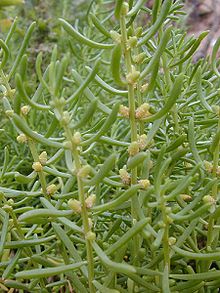Batis maritima
| Batis maritima | |
|---|---|
 |
|
| Batis maritima | |
| Scientific classification | |
| Kingdom: | Plantae |
| (unranked): | Angiosperms |
| (unranked): | Eudicots |
| (unranked): | Rosids |
| Order: | Brassicales |
| Family: | Bataceae |
| Genus: | Batis |
| Species: | B. maritima |
| Binomial name | |
|
Batis maritima L. |
|
| Synonyms | |
|
|
Batis maritima (saltwort or beachwort) is a halophyte. It is also known as turtleweed, pickleweed, barilla, planta de sal, camphire, herbe-à-crâbes, and akulikuli-kai. It is a C3-Plant, long-lived perennial, dioecious, succulent shrub. The plant forms dense colonies in salt marshes, brackish marshes, and mangrove swamps and frequently is found on the margins of saltpans and wind-tidal flats. Batis maritima is a pioneer plant, covers quickly areas where hurricanes have destroyed the natural vegetation.
So far, Batis maritima has not been used commercially for food production but the seeds have a high oil content with high nutritional value.
Plants are dioecious, perennial sub shrubs 0.1–1.5 m tall and form dense colonies. The succulent leaves are opposite and sessile. The small, white flowers of Batis maritima are self-incompatible and the morphology of the pollen indicate that the plant is wind pollinated.
Seeds are 1.1 mm long and 0.8 mm wide and have an extreme low weight (0.5 mg/seed). They have a smooth, very dark and hard walled coating and an elongated lenticular shape. It has been reported that they have germinated after several months of floating in seawater.
The primary root branches early in development and is unbranched until the shoot is 10 cm or more in height.
B. maritima occurs on both Atlantic and Pacific tropical coasts of the three Americas and the Caribbean Islands. The northern distribution (up to 33 uN latitude) appears to be influenced by frost events. Many sites where maritime saltwort occurs are subject to severe tropical storms. It typically occurs at elevations less than 1.0 m above mean sea level and at sites where salinity ranges from 18 to 50 ppt (muddy tidal banks, mangrove swamps, salt-marshes, mud and salt flats). It also grows in soils without salt but is vulnerable to competition from nonhalophytes.Batis maritima occurs in sites normally subject to minimal sand coverage. Wrack deposits seem to stimulate growth. Maritime saltwort has been reported as an invasive species in Hawaii, where it displaces native species.
The ability to produce adequate levels of biomass over a wide environmental range have been well documented. The plant is not seriously affected by insects, disease, or grazing, but the shoots cannot bear sand coverage.
Leaves occasionally are added to salads in Puerto Rico, it has also been used as a pot herb, puree and pickle [1] . The seeds are added to salads, they can be toasted or “popped” like corn. The Comcáac used the roots to sweeten coffee before they had access to sugar. The yellow to golden hued meal is used for food. Due to its high oil content it has the potential to be an oil crop. Batis maritima has been used in folk herbal medicine in Puerto Rico to treat gout, eczema, psoriasis, rheumatism, blood disorders, and thyroid disorders.
...
Wikipedia
